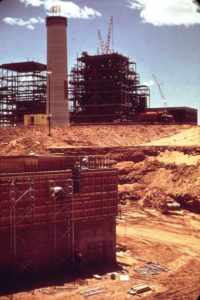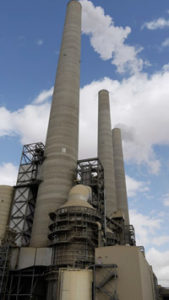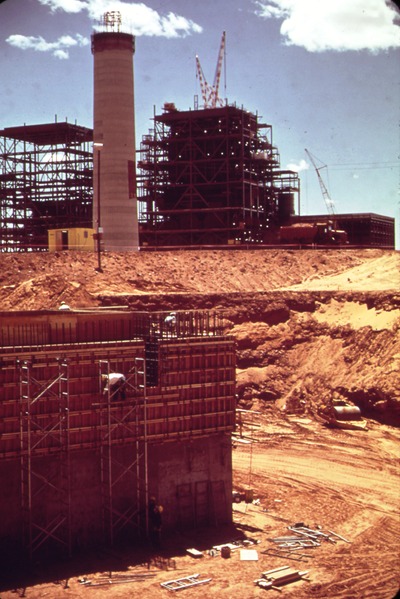A sign of the times?
The Navajo Generating Station (NGS), a coal-fired power plant located in the northern Arizona community of Page, is shutting down. Moreover, the 78-mile Black Mesa & Lake Powell (BM&LP) Railroad – built to haul the black carbonaceous rock between the mine and plant – is likewise itself terminating operations. Peabody Energy’s Kayenta Mine – where the generating facility’s coal supply was sourced – meanwhile, has been shuttered already.

The NGS’s story practically mirrors that of the Mohave Generating Station in Laughlin, Nevada, which preceded NGS’s closure by almost 15 years. It stopped generating in 2005. MGS had been supplied with coal from the Black Mesa Mine located very near to the Kayenta Mine.
The railroad, in service for close to 50 years, served its customers well. For the BM&LP the closure is bitter sweet and marks the end of an era. That the generating plant is closing, there will no longer be a need for the railroad.
A Black Mesa & Lake Powell hallmark was its fully electric operation. BM&LP has no physical rail connection to the national rail network – it is an isolated rail property, in other words. The railroad, according to Wikipedia, is owned by the Salt River Project. The supply of electricity comes courtesy of the Navajo Tribal Utility Authority.
Also according to Wikipedia, as to the coal hauled, it is classified as “high volatile C bituminous.” Its sulfur content is low, relatively speaking or 0.63 percent. The coal’s lower-sulfur content makes it less destructive to air and the environment when ignited where both sulfur dioxide (SO2) releases and the formation of acid rain are concerned.
To help further counteract this, scrubbers were added to the generating station in the late 1990s. The effectiveness of the scrubbers was such that better than 90 percent of SO2 emissions were removed. Other released pollutants connected to coal burning include mercury, oxides of nitrogen and fine particulates. Those emissions at the generating site were cut as well.

Also having to do with helping save the air is that in building the railroad and operating electric trains between mine and power plant, this means a number of truck moves could be eliminated. One railroad hopper car can haul enough coal to fill, at the very least, that which could be carried by two trucks and perhaps as many as three. Multiply that by the hundreds and it is easy to see how many truck-hauling-coal-moves could be removed from area roads, requiring a tractor apiece to pull each load and hence a significant amount of pollution removed from area air.
Natural gas is more and more substituting for less competitive and less attractive coal, the gaseous fossil fuel being the more environmentally friendly of the two.
The Navajo Generating Station will be online until December 2019.
For more about the Kayenta Mine, the Black Mesa & Lake Powell Railroad and the Navajo Generating Station go here, here and here, respectively.
Images: U.S. National Archives and Records Administration (upper); U.S. Environmental Protection Agency (lower)
Published by Alan Kandel

With the outlying communities where people live yet commute to Page, AZ for work in the tourism and support industries; this rail line should be converted to a light rail for those who need to commute.
It is both interesting and timely that you raise this point.
In Phoenix, the voters once again in a referendum, approved the extension of the Metro Rail light rail system. This happened despite a committed lobbying effort to try to keep this from happening. Wiser heads prevailed.
The suggestion for passenger rail service for the 78-mile line has merit. If electricity supplied by the sun was used to power the train (maybe the generating station could be converted into a solar farm) that would keep costs down. Interestingly and as it may relate, on the Byron Bay Railway in Byron Bay, Australia, two railroad passenger cars (at least one of them equipped originally with a diesel engine) were converted to 100 percent sun-powered as they were outfitted with solar panels on their roofs.
One advantage is that in the case of the Kayenta-to-Page line, it already has the electrical distribution and railway track infrastructure already in place.
Good suggestion as this would be a way to cut down on driving, roadway and vehicle wear-and-tear and polluted air.
I’d like to make a few points of correction to your story.
1. NGS is located just outside of Page in the Navajo Nation community of LeChee.
2. BM&LP Railroad’s last delivery of coal was Oct. 26. “Shuttered” is an unusual way to describe ceasing operations of a railroad.
3. The reasons for closure of Mojave and NGS could not have been more different. To say the reasons mirror each other is simply inaccurate.
4. “…there will no longer be a need for the railroad” is also inaccurate, if you checked with the Navajo Nation.
5. NGS’s SO2 scrubbers remove 95.% of SO2. Its ESPs remove 99.5% of fly ash.
6. BM&LP was an electric train specifically to prevent diesel emissions.
7. Each BM&LP coal car carried 100 tons.
8. Air quality across the Navajo Nation and Page, Ariz., is some of the cleanest in the country. The reason is no interstates, few roads, no railroads (other than the BM&LP electric train), no manufacturing and very low population across an area the size of northern New England. These are the principal sources of air pollution. Navajo’s air quality is better than Flagstaff, Ariz. Phoenix by comparison is an EPA non-attainment area. Forest fires are the biggest source of air pollution on Navajo.
Research available online found that years after Mojave closed, there was no perceptible difference in air quality in the Grand Canyon than before.
9. Converting BM&LP to a passenger line would have to overcome the problem that it ends 20.6 miles from the Navajo community of Kayenta and more than five miles from Page.
Appreciate the clarifications.
Though I did not write that the railroad is being “shuttered.” What I wrote was that the railroad is “terminating operations.” I did, however, write that Peabody Energy’s Kayenta Mine “has been shuttered already.”
You have indicated that the railroad’s “last delivery of coal was Oct. 26.” I am wondering if you meant Aug. 26 or was that Oct. 26 of last year?
It seems logical that the BM&LP Railroad was created so that truck hauls could be avoided, and less of a case where diesel emissions (from trucks, I assume) could be prevented.
As to your point number 9, it seems reasonable that the line could be extended to both Page and Kayenta.